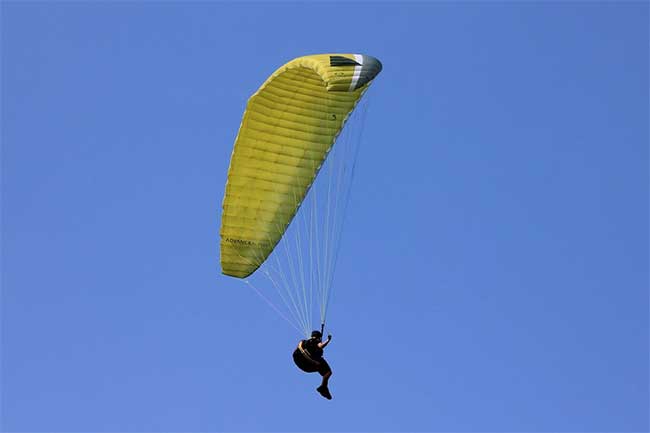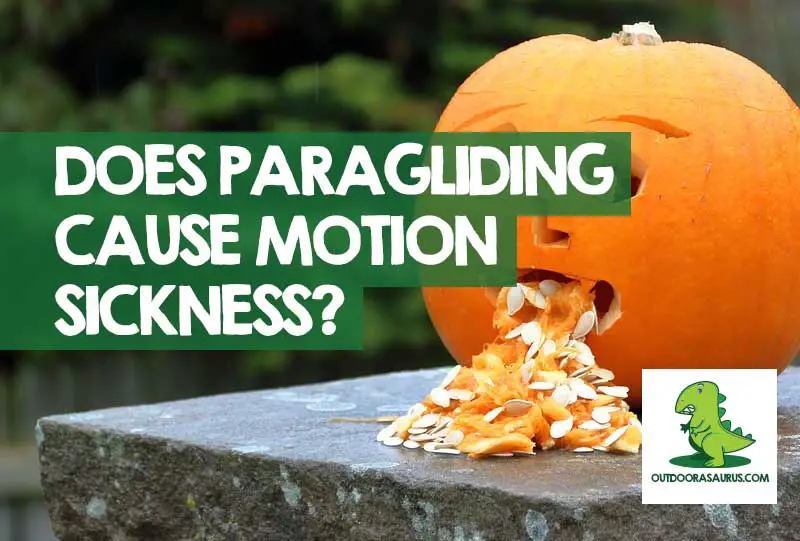Paragliding motion sickness is commonly experienced in beginners, particularly those who are initially paragliding in tandem with an instructor.
It’s probably due to the fact that as a passenger you aren’t in control of the movements, meaning your brain isn’t concentrating on any manual tasks as you aren’t doing the steering.
In most cases, paragliding motion sickness will go away once you have become used to the disorientation and movement your body is going through.
Most people I spoke to said that things seemed to get better after a few hours of flying time experience (and particularly once they started flying solo).

However, motion sickness can affect even the most experienced of paragliders.
In the guide below I am going to explain more about why paragliding causes motion sickness, how you can prevent it from happening, and ways in which you can treat it after the event.
Does paragliding cause motion sickness?
Yes, paragliding can cause motion sickness in some people. It’s a very common complaint in beginners flying in tandem or with paragliders who are just beginning to fly thermals. According to research, women are more susceptible to paragliding motion sickness.
But, it’s key to understand that not everyone will get motion sickness when paragliding.
The US National Library of Medicine reports that:
“About 1 in 3 people are considered highly susceptible to motion sickness. However, almost everyone will become motion sick if exposed to motion that is intense enough.”
Interestingly, they say that motion sickness can be more common in certain groups of people than others (read the report), although it’s not understood why this is.
According to the research, women are more susceptible to the condition, particularly those who fly when pregnant (click here for more information on paragliding when pregnant).
Other people at risk are those that have a history of migraines or balance disorders (known as vestibular migraines).
The report also published research to suggest that (weirdly) certain ethnic and geographic groups can be more susceptible, with Asians having a higher rate or motion sickness that Europeans.
What causes motion sickness in paragliding?
Motion sickness occurs due to an imbalance between what you are seeing in front of you, and what your body is actually feeling.
When paragliding, the glider is moving in a forward direction, but your body is effectively standing still.
This cause an imbalance, caused by the conflicting signals being sent between the inner ear, your eyes, and sensory receptors in your brain.
What are the symptoms of motion sickness?
Motion sickness can range from mild to severe and will manifest itself with any of the following symptoms, or a combination of.
- Feeling dizzy
- Feeling sick and tired
- Producing more saliva than normal
- Experiencing headaches
- Vomiting and feeling nauseous
- Starting to burp.
- Starting to sweat excessively
How to prevent motion sickness when paragliding
Let’s get down to the crux of the matter. If you are worried about it then how can you prevent motion sickness when paragliding?
To find out how, I did some online research, but also spoke to some experienced paragliders too, and have included their comments.
First up, here’s the advice you might get from a doctor.
- Avoid alcohol before flying: and I don’t just mean in the 10 minutes leading to take off. Don’t drink any alcohol for up to 24 hours (and possibly more) before you take flight.
- Eat light before flying: don’t have a huge meal before paragliding, and also try to avoid greasy goods, spiced ingredients, or heavy carbs.
- Use travel sickness pills before flying: you can buy commercial motion sickness tablets from your local pharmacy, taking one 30 minutes before you paraglide. It has also been said that a cup of coffee and one aspirin can have the same positive effect.
- Look at a fixed object: when in the air and flying, try to keep your eyes set on a fixed point on the ground or horizon. For example, you might see a landmark when paragliding, so keep your eyes watching that at all times.
- Be in control: as mentioned, beginner paragliders will experience motion sickness more because they aren’t in control. Tests show that motion sickness is greatly reduced when the person is in control. Once you are able to be in control yourself, motion sickness will most likely cease to be an issue.
- Close your eyes: if the motion sickness gets really bad during flight, close your eyes for a while. This will eliminate the sensory confusion that your sight is sending to your brain and could give you some respite from nausea.
- Use relaxation techniques: try to reduce your heart rate by thinking about something more relaxing, which will in turn help to lessen the feeling of motion sickness. As part of the relaxation technique, focus on breathing control and relaxing your muscles.
Whilst those could help you stop the motion sickness once airborne, the truth is, it’s very hard to completely eliminate once is starts until you have got back onto the ground.
Handy Hint: Want to know what paragliding really feels like? I interviewed 13 people who had gone paragliding for the first time. You can read all about their experiences and feelings here.
How to treat motion sickness after paragliding
It’s well established that the best treatment for motion sickness is to prevent it happening at all. The old adage of prevention better than cure is never been more relevant – try preventative methods before you take flight and the actual motion starts.
You can buy motion sickness pills, but they could cause drowsiness. That means that ideally they are best taken after the flight than before you fly (if you are solo flying).
But if you are feeling sick after a flight, they can also help as they work by calming the inner ear nerves and can soothe the part of your brain causing the vomiting.

There is also some research to suggest that raw ginger can help. You can eat it in a pure format, or mash it up and place it into a fruit tea with boiling water.
One of the best pieces of advice I was ever given for motion sickness was to lie down under a shaded tree, rest, and take advantage of some peace and quiet.
But you can only do that once you stopped paragliding, but it should quickly help to alleviate the feeling of nausea.
The best advice though is to ask your doctor or pharmacist to see what they will personally recommend for you.
Advice from paragliders on preventing motion sickness
I also listened to some podcasts and looked up some techniques on paragliding forums to see what the professionals were saying about motion sickness prevention. Here’s a selection of the best comments.
“Don’t give up after just one tandem flight. As to go again, but this time request that the pilot flies you on a gentler tour. If you find you don’t get as sick, it’s a sure-fire sign that you should be fine once you start flying solo.”
“I used to get motion sickness during my first few months of paragliding solo and thermalling, but found I was ok if I sucked some boiled sweets during the flight.”
“Try travel sickness tablets and take one 30 minutes before you take off. Other people will suggest natural remedies such as copper bracelets and ginger, but a proper tablet is going to work way better. Your body will adapt over time to the point where you no longer need to take them.”
“When I learnt to fly, I chucked up everywhere after my first session. My instructor promised me that the motion sickness would pass, and he was bang on. After three days of paragliding I was completely fine, and it’s never come back!”
Conclusion
For those just starting out with paragliding, tandem flights could make you feel sick if you are one of the 1 in 3 people prone to the condition.
However, it’s commonly accepted that it will be much better once you are able to fly solo and are in full control of the glider yourself.
Experienced paragliders say that it takes time to feel completely at ease with the glider, particularly when you encounter turbulence and thermals that will shift your position around.
So don’t worry too much.
Book some more tandem flights and over time you should start to find that your motion sickness reduces considerably, until the point you are over it.
Please note: This article is not intended to be medical advice and you should always consult a qualified healthcare professional before paragliding.

